The Essential Guide to Choosing a Bathroom Garbage Can
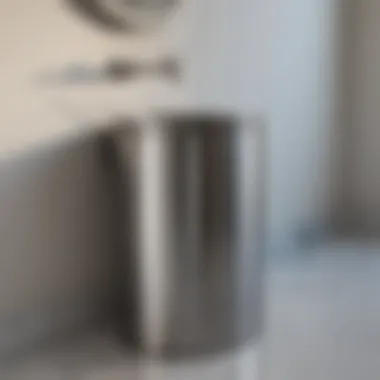
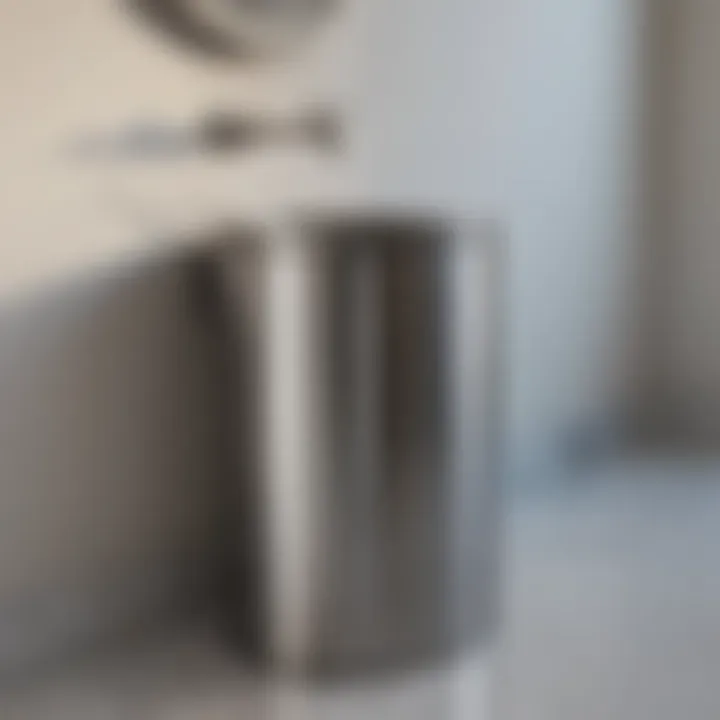
Intro
Choosing the right bathroom garbage can is often an overlooked aspect of home decor. However, it plays a significant role in maintaining both cleanliness and aesthetic appeal in this intimate space. As one considers the various options available, several factors come into play such as size, material, and style. Understanding these elements can transform a mundane task into a seamless experience, underscoring the importance of thoughtful choices.
This guide aims to help homeowners and renters alike navigate the array of choices in bathroom garbage cans. The focus is on practicality and style, ensuring that each selection aligns well with individual preferences and needs. In different bathrooms—from compact spaces to more spacious environments—the right garbage can can optimize functionality while harmonizing with one’s overall interior design.
Trending Styles
Modern Minimalism
Modern minimalism stands out for its sleek lines and uncluttered appearance. A bathroom garbage can in this style is often made from stainless steel or matte plastic. These materials resist smudging and fingerprints, making maintenance easier. One popular option in this category is the Simplehuman Rectangular Step Trash Can. It incorporates a step mechanism for hands-free use, appealing to those who prioritize hygiene.
Cozy Rustic
For a warmer, more inviting atmosphere, a cozy rustic style is often preferred. Items in this category are typically made from wood or wicker, adding natural textures to the bathroom. They tend to feature warm tones and organic shapes, contributing to a serene environment. One notable brand is the მრშოთე rustic wood wastebasket, which captures the essence of this style effectively.
Color Palettes
Calming Neutrals
Neutral tones such as white, beige, and gray are timeless choices. They ensure the garbage can blends seamlessly into the background, allowing the primary design elements of the bathroom to shine. A white or beige garbage can can create a fresh, clean look that aligns well with various decor styles. The Umbra Skinny Can is a great example of combining functionality with this color scheme.
Bold Accents
On the other end of the spectrum, bold colors can add a striking visual impact. A bright red or deep navy garbage can may serve as a focal point, drawing the eye and stirring conversation. This approach works well in a bathroom equipped with neutral tiles and fixtures. The Rubbermaid Classic Step-On Trash Can, with its array of vibrant options, is worth considering for those looking to introduce personality into their space.
Choosing a garbage can may seem trivial, but it can significantly impact the overall feel of your bathroom.
The selection of color should reflect personal taste while being practical for the use case. In a bathroom, materials that resist water and stains are ideal, ensuring durability over time.
By understanding the various styles and color palettes available, it's easier to make informed decisions regarding bathroom garbage cans. This comprehensive guide aims to empower readers with the knowledge needed to harmonize utility and style in their chosen bathroom space.
Understanding the Role of a Bathroom Garbage Can
A bathroom garbage can is often overlooked in terms of its significance. It plays a crucial role in maintaining order and cleanliness in one of the most utilized spaces in a home. Many people might not realize that the choice of garbage can can affect daily routines and overall hygiene. Selecting the right type can enhance both functionality and style, contributing to a more organized environment.
Functional Importance
The primary function of a bathroom garbage can is straightforward but essential: it provides a designated place for disposing of waste. This is important for various items, including tissues, cotton swabs, and other small refuse that accumulates throughout the day. An effectively chosen garbage can helps in keeping the bathroom clutter-free.
When evaluating options, it’s beneficial to consider features such as size, lid type, and opening mechanism. For example, a smaller can may be suitable for a half-bath, while a larger can is necessary for a busy family bathroom. Additionally, the ease of access to the can influences how consistently it will be used. If it’s difficult to reach, chances increase that people will toss waste elsewhere. Thus, functional importance is not limited to waste containment but includes accessibility and usability as well.
Impact on Hygiene
Hygiene is a vital aspect of any bathroom. A poorly chosen garbage can can lead to unsightly messes and potential health risks. For instance, open cans can harbor foul odors, attract insects, and allow germs to spread. Selecting models with lids—such as step-on or touchless varieties—mitigates these risks effectively. These types minimize contact, inherently promoting better hygiene.
It is also important to assess the material of the garbage can. Certain materials are naturally more hygienic and easier to clean than others. A metal can is generally more durable and easier to wipe down, compared to plastic. Overall, the right bathroom garbage can not only contains waste but also contributes to a healthier living environment.
"The choice of a bathroom garbage can extends beyond aesthetics—it directly influences cleanliness and hygiene within the space."
By understanding the essential roles of a bathroom garbage can, homeowners can make more informed decisions. This consideration is vital for enhancing both functionality and hygiene, ultimately fostering a more pleasant and safe bathroom atmosphere.
Types of Bathroom Garbage Cans
Choosing the right type of bathroom garbage can is a fundamental step in curating an efficient and aesthetic space. The type of can you select influences functionality, ease of use, and overall bathroom cleanliness. Understanding the distinct characteristics of each type enables homeowners and housewives to match their needs with appropriate options. Each category presents a set of benefits and considerations that fit various lifestyles and preferences.
Step-on Cans
Step-on cans offer a hands-free solution, making them particularly advantageous in a bathroom setting. The foot pedal mechanism allows users to open the lid without needing to touch the can, which ensures a more hygienic experience. This design minimizes contact with germs, an essential factor in a space that often harbors moisture and bacteria. Additionally, step-on cans typically feature a sturdy construction that can support frequent use without wear.
Advantages of step-on cans include:
- Convenience: Ideal for quick disposal of items without needing to use your hands.
- Variety in Sizes: Available in different capacities to fit diverse bathroom spaces.
- Design Choices: Often come in sleek designs to complement modern decor.
Considerations when selecting a step-on can include its durability, ease of mechanism, and the material used. Opting for a can with a removable inner bin makes cleaning straightforward, ensuring the can remains in top condition.
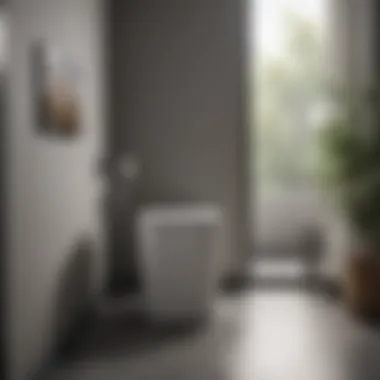

Touchless Models
Touchless garbage cans are becoming more popular, driven by advances in technology. These cans employ motion sensors to automatically open the lid, which is a significant benefit for those prioritizing hygiene. They reduce the chance of cross-contamination by eliminating the need for physical contact entirely. Touchless models can also enhance the sense of modernity in a bathroom environment.
Key benefits of touchless cans:
- Hygienic: Best for preventing contact with unsanitary surfaces.
- User-Friendly: Great for individuals with limited mobility or small children.
- Energy Efficiency: Many models have features that prolong battery life or allow for rechargeable options.
However, these models may require occasional changes of batteries or charging, which could be a drawback for some users. It is important to assess the sensor sensitivity and responsiveness of different models when making a selection.
Swing Lid Cans
Swing lid cans feature a lid that swings open when you push against it, offering a blend of convenience and accessibility. They provide easy access for tossing out waste while also maintaining a level of coverage to avoid unpleasant odors. This type of can is suitable for those who prefer a traditional approach without the necessity for step-on or touchless features.
Advantages include:
- Affordability: Generally economical and widely available.
- Simplicity: Easy to use, requiring no complex mechanisms.
- Versatility: Suitable for various waste types, from bathroom items to recyclables.
The consideration with swing lids is the need for regular cleaning around the edges to prevent buildup. Choosing materials that resist stains and odors can extend the durability of this option.
Open Top Cans
Open top cans lack a lid, making them the most uncomplicated and straightforward option. They are easy to access, which encourages regular use, ensuring waste does not accumulate in the bathroom. However, this design may lead to odor and visibility issues, so it’s essential to manage usage and cleanliness.
Pros of open top cans:
- Convenience: Quick disposal without any lid complications.
- Cost-Effective: Typically less expensive than other types.
- Wide Accessibility: Easy for everyone in the household to use, including children.
That said, they require a commitment to cleanliness and may necessitate more frequent emptying. Utilizing inner liners can help in managing odor and waste visibility.
In summary, selecting the appropriate type of bathroom garbage can depends on personal preferences, desired features, and lifestyle considerations. This choice can significantly impact the bathroom’s hygiene and functionality, making it vital to assess each option critically.
Materials Used in Bathroom Garbage Cans
When selecting a bathroom garbage can, the material is a fundamental factor that influences both functionality and aesthetics. The right choice of material not only affects the visual appeal of the can but also its durability, hygiene, and maintenance requirements. Understanding the benefits and considerations associated with different materials ensures that the selection meets practical needs while integrating smoothly into the bathroom's overall design.
Plastic
Plastic garbage cans are a prevalent choice due to their affordability and lightweight nature. They come in various shapes and sizes, making it easy to find one that fits your specific space. One notable advantage of plastic is its resistance to moisture, which is crucial in a bathroom setting.
In addition to being lightweight, plastic cans offer flexibility in design. They can be molded into various styles and colors, allowing them to blend with different decor themes. Though not as durable as some other materials, modern plastics can withstand daily use without cracking or breaking.
Drawbacks of plastic include potential sensitivity to heat, which can lead to warping. Additionally, some lower-quality plastics may retain odors over time. Opting for high-density polyethylene or similar types can mitigate these issues.
Metal
Metal garbage cans present a more robust alternative to plastic. Often made from stainless steel or aluminum, metal cans are known for their durability and sleek appearance. They can withstand heavy use, making them suitable for families or high-traffic bathrooms.
Stainless steel is notable for its resistance to rust and corrosion, enhancing longevity. Metal cans are often easier to clean than their plastic counterparts since they do not absorb odors or stains as easily.
However, downsides include weight, which can make them more cumbersome to move. Furthermore, metal cans can also dent or scratch, potentially affecting their aesthetics.
Bamboo
Bamboo garbage cans are among the more eco-friendly options available. They provide a natural, organic look that can enhance the aesthetic of any bathroom space. As a sustainable resource, bamboo grows quickly and is biodegradable, appealing to environmentally conscious consumers.
While bamboo is not as robust as metal, it is still a sturdy material if treated properly. It often comes with a protective coating to increase its resistance to moisture and stains.
That said, bamboo requires more maintenance to keep it looking its best. It can warp or become discolored if constantly exposed to water without proper care.
In summary, the choice of material for a bathroom garbage can is crucial. Each option provides unique benefits and considerations. Balancing aesthetics, functionality, and maintenance needs can help in selecting the best fit for your bathroom.
Choosing the Right Size
Selecting the correct size for a bathroom garbage can is paramount for functionality and aesthetics. The right size ensures that the can accommodates your waste needs without overwhelming the available space. It also influences how frequently you need to empty it, impacting overall hygiene. A properly sized garbage can allows for better waste management, preventing overflow and unpleasant odors.
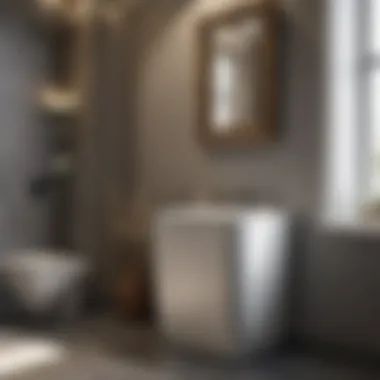
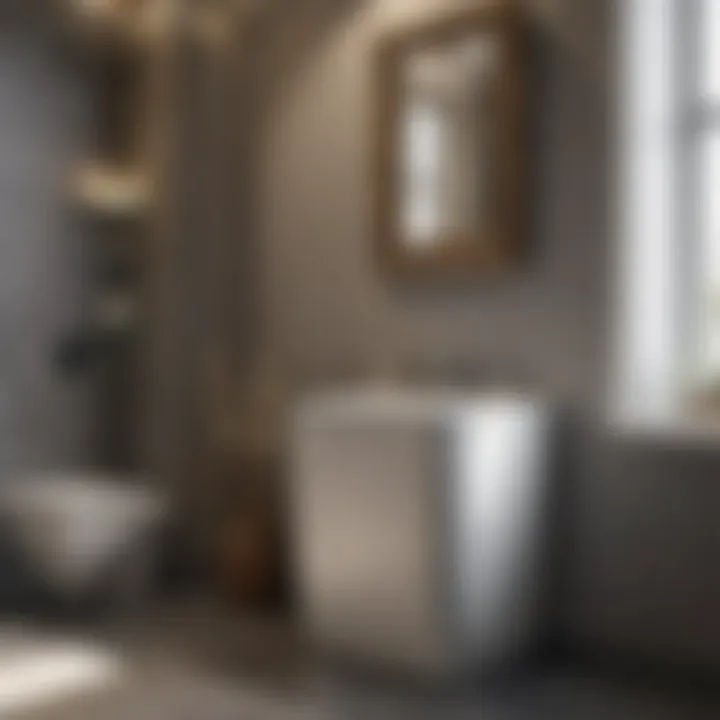
Assessing Available Space
Before making a purchase, it is essential to evaluate the space where the garbage can will reside. Measure the designated area, taking note of any nearby fixtures, like sinks or cabinets, that might restrict access. The ideal garbage can should fit comfortably, leaving enough room for movement without obstructing pathways. In smaller bathrooms, compact designs may be more suitable, while larger spaces may allow for more variety in size.
It is also wise to consider the location. Placing the can in an easily accessible spot, such as next to the toilet or near the sink, can encourage its use, promoting better waste disposal habits. Moreover, determining the height is crucial; a too-tall can might create an visual imbalance with other bathroom features.
Understanding Usage Needs
Understanding how you will use the bathroom garbage can directly informs the size you requir. If your household generates a significant amount of waste, a larger can might be necessary. Consider the types of items you throw away. For instance, if you often dispose of personal hygiene products, a can with a lid may be preferable, even if it is larger.
On the other hand, a household with less waste might benefit from a smaller model. This can help reduce the visual clutter in the bathroom. Another aspect to consider is the style of the can. Leveraging a stylish design can enhance your bathroom decor, while also fulfilling the practicality of waste disposal. Overall, assessing your own habits will ensure you select a bathroom garbage can that meets your unique needs.
Design Considerations
When selecting a bathroom garbage can, it is crucial to consider design. The garbage can can often be a highlight of your bathroom decor. How it looks can impact the overall aesthetics of the space. A well-placed and stylish garbage can complements the bathroom's design while serving a functional purpose. Here, we delve into several facets of design that can influence your choice.
Style Coordination
Choosing a garbage can that aligns with the existing style of your bathroom is paramount. If your bathroom has a modern design, a sleek stainless steel or a minimalist touchless model may enhance its appeal. Conversely, in a more traditional setting, a vintage-style can might complement the decor elements.
When considering style, evaluate the fixtures, tiling, and overall theme of the bathroom. A mismatched garbage can disrupts visual harmony. Aim for cohesion to create a polished look.
Color Matching
The color of the garbage can is another essential consideration. Selecting a shade that complements or contrasts beautifully with bathroom colors can either highlight or subtly integrate the can. Neutral tones such as white, gray, or black are versatile and can blend seamlessly with various themes.
Yet, bold colors can serve as a statement piece, offering a pop of color to an otherwise muted palette. Think about your color scheme and choose wisely to enhance the bathroom's ambiance.
Footprint and Shape
The footprint and shape of the garbage can affect its functionality and placement. A wider base provides stability but may need considerable floor space, whereas a taller, slimmer design can fit into tighter spots without compromising capacity.
Consider also the functional aspects:
- Square or Rectangular: These shapes often fit neatly against walls and maximize space.
- Round: Round can designs are often more visually appealing and can have a softer look.
- Unique Shapes: Some modern designs incorporate unique shapes which can add character, but may not fit traditional slots well.
In summary, the design considerations for a bathroom garbage can extend past mere aesthetics. Each element plays a role in ensuring that this functional item enhances your bathroom experience rather than detracting from it.
Factors to Consider for Maintenance
When selecting a bathroom garbage can, maintenance is a significant factor to take into account. A highly functional bathroom must prioritize cleanliness and efficiency, and the garbage can plays a pivotal role. By understanding the elements of maintenance, one can enhance both the longevity of the product and the overall hygiene of the bathroom environment.
Ease of Cleaning
A bathroom garbage can that is easy to clean significantly contributes to maintaining a hygienic space. Regular cleaning is essential due to the nature of items disposed of in bathroom trash bins, which may include tissues, cotton swabs, or other personal care products. An ideal garbage can should have a smooth surface that does not trap debris, allowing for quick and efficient cleaning. Many plastic and metal options can simply be wiped down with disinfecting wipes or a damp cloth.
Consider a model without intricate designs, as these may collect dirt in crevices. The base of the can is another critical area. Cans with a solid base minimize the risk of liquids or waste seeping under and causing odors. This ensures that the surrounding area remains fresh and clean.
Liner Compatibility
Compatibility with liners is another key aspect of maintenance. Liners provide a protective layer for the can, making it easier to manage waste without direct contact. This is particularly relevant in bathrooms where moisture can lead to odors and bacteria growth. A can designed to work seamlessly with specific liner sizes can improve usability, reducing the likelihood of spills during removal.
Different materials will also affect liner choice. Plastic cans can often accommodate standard plastic liners, while metal ones may require heavier-duty options to manage heavier waste loads. It is wise to ensure that the chosen garbage can has ample space to allow for easy insertion and removal of liners.
Additionally, using biodegradable liners can contribute to eco-friendly practices while maintaining cleanliness.
Remember, a little attention to maintenance can greatly enhance the lifespan and function of your bathroom garbage can.
Environmental Implications
In today's world, the choices we make play a significant role in the environment. Bathroom garbage cans, often overlooked, have important environmental implications. Selecting the right type can influence resource conservation and waste management. By being mindful of materials and disposal methods, homeowners can contribute to a more sustainable future.
Recyclable Materials
Choosing a bathroom garbage can made from recyclable materials is a crucial step in promoting environmental health. Many types of plastic, for example, can be recycled. Likewise, metal cans tend to have higher recycling rates compared to their plastic counterparts. When selecting a garbage can, look for products that explicitly indicate they are made from materials that can be recycled.
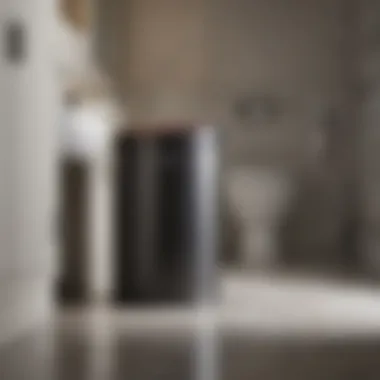

Here are some commonly recyclable materials:
- Plastic: High-density polyethylene (HDPE) is often used, which is widely accepted in recycling programs.
- Metal: Aluminum and steel cans can be melted down and reused.
- Glass: While less common for bathroom garbage cans, glass is a recyclable material that poses minimal environmental impact.
By placing recyclable materials in the right waste disposal streams, the cycle continues. Once recycled, these materials can be reintroduced into manufacturing processes, creating new products and reducing the need for virgin resources.
Sustainable Practices
Sustainable practices in choosing a bathroom garbage can go hand-in-hand with selecting recyclable materials. It is important to consider the overall life cycle of the product. This includes not just disposal but also the manufacturing process and materials sourcing.
Opting for companies with sustainable sourcing policies helps ensure that your garbage can is made responsibly. For instance, if a manufacturer sources bamboo, a fast-growing renewable resource, this can reduce the carbon footprint significantly.
Consider these sustainable practices when choosing a garbage can:
- Local Sourcing: Products made locally are usually transported shorter distances, which reduces transportation emissions.
- Sustainable Manufacturing: Companies that use eco-friendly practices in production tend to minimize pollution.
- Durability: Selecting a durable product means it will need replacement less often, which conserves resources in the long run.
When it comes to choosing a bathroom garbage can, your decision ripples through the entire life cycle of the product.
In summary, understanding the environmental implications of the bathroom garbage can aligns with broader efforts in sustainability. It encourages responsible consumer behavior that can have a lasting impact on our planet.
Integration into Bathroom Layout
Integrating a bathroom garbage can into your bathroom layout is crucial for creating a functional and aesthetically pleasing environment. This consideration goes beyond merely placing a bin in a corner. You need to think about how it fits within the overall design and functionality of the space. A well-placed garbage can enhances both efficiency and accessibility, making it easier to maintain cleanliness without disrupting the bathroom's visual harmony.
When deciding on the placement of a bathroom garbage can, focus on key elements such as convenience, visibility, and space utilization. The can should be easily reachable, especially in a room where residents and guests may need to dispose of items quickly. Think about the types of items typically thrown away in a bathroom—from used tissues to product packaging. You want to position the can where it is most needed, but not so much that it becomes an eyesore.
Another benefit of strategic integration is that it can encourage proper disposal habits. When a garbage can is accessible, users are more likely to utilize it, contributing to better hygiene and cleanliness. Additionally, consider the traffic flow in your bathroom. A poorly placed can may create obstacles or disrupt pedestrian movement, which can lead to frustration.
Placement Strategies
Placement strategies require careful thinking about both visibility and accessibility in your bathroom layout. Here are several guidelines:
- Near the Vanity: Positioning the can near the vanity allows easy access for disposing of waste while using the sink.
- Underneath a Counter: This keeps the bin out of sight, maintaining the aesthetic flow while still being useful.
- Next to the Toilet: Given that items like toilet paper rolls or hygiene products may need disposal, a can nearby is practical.
- Corners or Hidden Areas: Utilize corners or hidden sections to maximize space without sacrificing accessibility.
Accessibility Considerations
Accessibility considerations are important for the optimal functioning of your bathroom garbage can. Not all users will have the same needs, so understanding who will use the space helps.
- Height and Reach: Ensure that the can is at a height that makes it easy for every user to access. Traditional styles may be too high for young children or those with mobility issues.
- Clear Pathways: Avoid clutter around the garbage can, as a clear pathway ensures ease of access. Placing the can in high-traffic areas without obstruction will enhance usability.
- Visual Signals: If the bin is semi-hidden, using visuals like labeling or decorative features can remind users of its location.
Integrating a bathroom garbage can effectively into the layout can elevate both the practicality and cleanliness of the space. By considering placement strategies and accessibility factors, you will create a more user-friendly environment.
When to Replace Your Bathroom Garbage Can
Replacing your bathroom garbage can is a task often overlooked, yet it carries significant importance. Maintaining functionality and hygiene in your bathroom environment necessitates more than just the initial selection of an appropriate can. Over time, even the most durable units can suffer from wear and accumulate unpleasant odors. Knowing when to replace your garbage can is crucial for preserving both cleanliness and aesthetic in your bathroom.
Signs of Wear and Tear
Recognizing signs of wear and tear is essential in determining when to replace your bathroom garbage can. Some common indications include:
- Physical Damage: Cracks, dents, or rust in metal cans can drastically reduce their effectiveness. Plastic cans can develop cracks and lose their integrity over time.
- Discoloration: Stains or discoloration can signal that materials are degrading. This is often a result of exposure to moisture and cleaning products.
- Flaking Paint: If your can is painted, look for signs of flaking or peeling. This not only affects appearance but can also lead to rusting or other forms of damage beneath the paint.
- Odor: A persistent unpleasant smell can indicate that the material has absorbed odors or has become a breeding ground for bacteria. If thorough cleaning does not resolve this, replacement may be necessary.
- Hinge and Lid Issues: If the lid does not fully close or the hinge is broken, it may no longer be effectively containing waste, thus creating a hygiene risk.
"A garbage can in disrepair can tarnish the entire bathroom experience, making attention to detail a necessity."
Functional Limitations
Noticing functional limitations is another critical aspect in deciding to replace your bathroom garbage can. Such limitations can include:
- Insufficient Capacity: Over time, the amount of waste generated may exceed the can's capacity. If you find yourself emptying the can frequently, consider upgrading to a larger model.
- Difficult to Use: If a can becomes cumbersome or complicated to operate, it may discourage proper use. For example, if a step-on pedal fails to work, it can become a nuisance, leading to poor hygiene practices.
- Ineffective Sealing: A poorly sealed lid can leave odors and waste visible. An ineffective sealing mechanism means that the can may not fulfill its primary function of odor control and waste management.
- Outdated Design: As styles and preferences evolve, an updating design may be necessary for visual coherence in an updated bathroom space. An outdated look can clash with modern aesthetics, making it a candidate for replacement.
Keeping an eye on these elements will ensure that your bathroom remains not just functional but also visually appealing.
End
In the realm of home management, the selection of a bathroom garbage can may seem trivial, yet it embodies several important considerations that deserve attention. This article has identified various factors that affect the choice and utility of a bathroom garbage can. Recognizing these elements is essential not only for maintaining hygiene but also for enhancing the overall aesthetic of the bathroom.
A quality bathroom garbage can serves multiple roles. It is primarily a functional item, critical for waste disposal. Yet, it also contributes to the visual appeal and organization of the space. By choosing the right type, material, and design, homeowners can achieve both practicality and style. Accessibility and maintenance are also key attributes to ensure effective use over time. The implication of integrating such a piece into your home's design warrants reflection.
Furthermore, the environmental aspect cannot be overlooked. The materials used and the recycling practices associated with bathroom waste containers significantly impact our surroundings. Opting for sustainable options can lead to broader ecological benefits, thus aligning personal choices with global needs.
As we summarize the key points from this exploration, it becomes clear that the selection of a bathroom garbage can impacts more than merely disposal. It affects sanitation, design coherence, and environmental footprint, making the decision a holistic one that connects practical living with conscientious choices.















